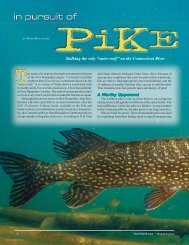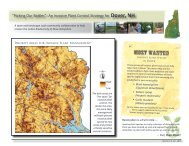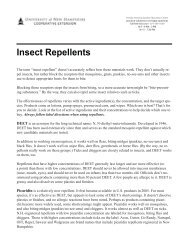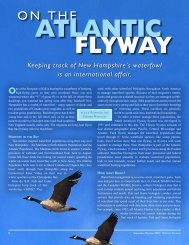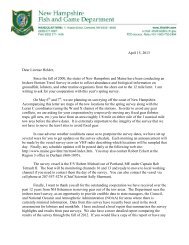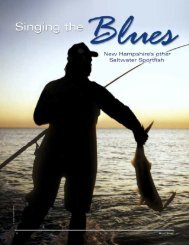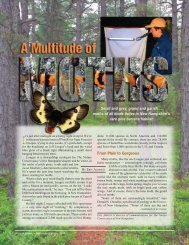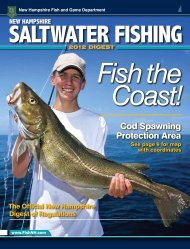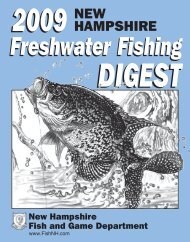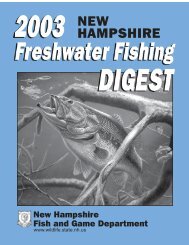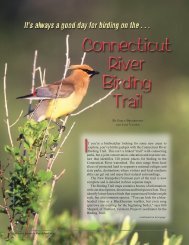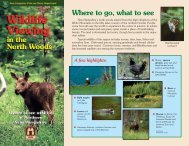Horseshoe crabs - New Hampshire Fish and Game Department
Horseshoe crabs - New Hampshire Fish and Game Department
Horseshoe crabs - New Hampshire Fish and Game Department
- No tags were found...
Create successful ePaper yourself
Turn your PDF publications into a flip-book with our unique Google optimized e-Paper software.
Where do they mate? You can helpIn their quest to identify the potential horseshoe crab mating beaches aroundGreat Bay Estuary, researchers are tracking “masses” of horseshoe <strong>crabs</strong>. If yousee a large group, please make note of the following, <strong>and</strong> send your observations toHelen Cheng at hrw24@wildcats.unh.edu.• Beach/mating location, including closest address to the location <strong>and</strong> l<strong>and</strong>marks,so that researchers can attempt to get GPS coordinates <strong>and</strong> locatethe horseshoe <strong>crabs</strong>.• Approximate numberof horseshoe <strong>crabs</strong>seen.• Any tagged animals(see photo) – <strong>and</strong>, ifpossible, tag numbers.• Day <strong>and</strong> time seen.for these important animals, including the Carl N.Shuster Jr. <strong>Horseshoe</strong> Crab Reserve, which protects1,500 square miles off of the mouth of DelawareBay. Despite recent efforts to reduce harvest rates ofhorseshoe <strong>crabs</strong>, sadly, red knots are not showing anysign of recovery.The <strong>New</strong> <strong>Hampshire</strong> <strong>Fish</strong> <strong>and</strong> <strong>Game</strong> <strong>Department</strong>takes part in the coast-wide effort to monitor the populationsof horseshoe <strong>crabs</strong>. In the Great Bay Estuary,an annual survey is conducted at index stationsthroughout the bay. Biologists walk 300-foot transectsat five stations on the new <strong>and</strong> full moons fromMay through July. The sites include Wagon Hill Farm,Adam’s Point, Chapman’s L<strong>and</strong>ing, S<strong>and</strong>y Point <strong>and</strong>Emery Point. The horseshoe <strong>crabs</strong> within the transectare counted, sexed <strong>and</strong> measured. Water temperature,salinity <strong>and</strong> weather conditions are also recorded. Thebiologists also try to capture juvenile horseshoe <strong>crabs</strong>using a dip net, but with little success. Juveniles arebelieved to inhabit areas close to their hatching location,but often burrow in the sediment, making themnext to impossible to catch. Though the annual surveyallows biologists to monitor trends in the populationover time, it doesn’t tell them how many horseshoe<strong>crabs</strong> actually inhabit Great Bay. That is about tochange.Promising <strong>New</strong> ResearchAn exciting horseshoe crab research project isunderway at the University of <strong>New</strong> <strong>Hampshire</strong>.Master of Science Degree c<strong>and</strong>idate Helen Cheng isstudying horseshoe <strong>crabs</strong>, in part to provide managerswith a better estimate of the size of the populationliving in the Great Bay Estuary. She is also workingto identify the critical habitats horseshoe <strong>crabs</strong> useduring each stage of their lives. To determine this,Cheng is establishing a monitoring system similarto the annual spawning horseshoe crab surveys inDelaware <strong>and</strong> Massachusetts. Trained volunteerswill walk the high tide line of beaches, recordingthe number of horseshoe <strong>crabs</strong> present inside each“quadrat” (a square plastic or metal device of knownarea used for sampling purposes) for a given distance,<strong>and</strong> tagging each with an external marker as part ofthe Cooperative Tagging Program of the U.S. <strong>Fish</strong><strong>and</strong> Wildlife Service. The data gathered will provideinformation about the approximate size of the localpopulation in Great Bay; additionally, over time, wecan learn the spawning frequency among males <strong>and</strong>females, <strong>and</strong> whether they use different spawningbeaches to lay multiple clusters of eggs or if they continueto frequent the same beach.Little is known about juvenile horseshoe crabhabitats in Great Bay. Cheng’s hypothesis is thatthey inhabit the mudflats adjacent to the spawningbeaches. They are difficult to locate because theyare very small <strong>and</strong> tend to burrow into the mud.Cheng plans to adapt methods developed by anotherresearcher who has had success finding <strong>and</strong> studyingjuvenile horseshoe crab habitats in Delaware Bay withthe use of a suction-dredge device. By constructing asimilar device to use in Great Bay, Cheng hopes thatshe will be able to discover where juvenile horseshoe<strong>crabs</strong> make their homes. Once we have more specificsabout the juveniles’ whereabouts, we can work toprotect their habitats. Research like Cheng’s is criticalto local managers <strong>and</strong> organizations involved withhorseshoe <strong>crabs</strong>.Survival of a SpeciesMost people I encounter on the annual monitoringsurvey know very little about horseshoe <strong>crabs</strong>,especially the fact that they were swimming inthe sea before the age of the dinosaurs. Hopefully,after learning more about them <strong>and</strong> the importancethey play in the ecosystem, people will have a newappreciation for horseshoe <strong>crabs</strong>. After all, they havesurvived for hundreds of millions of years, whereasmodern humans as a species are estimated to havebeen around for a mere 200,000. No one knows whatthe planet <strong>and</strong> its inhabitants will be like over the next400 million years, but it’s certainly worth our effortsnow to ensure that the horseshoe crab will survive towatch it unfold.Jessica Fischer is a marine biologist in N.H. <strong>Fish</strong> <strong>and</strong><strong>Game</strong>’s Region 3 office in Durham. She works withAmerican eel, rainbow smelt, northern shrimp, searunbrown trout <strong>and</strong> horseshoe <strong>crabs</strong>.12 July/August 2012 •



